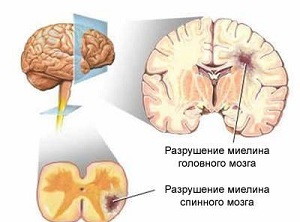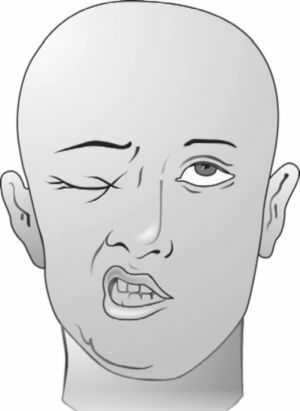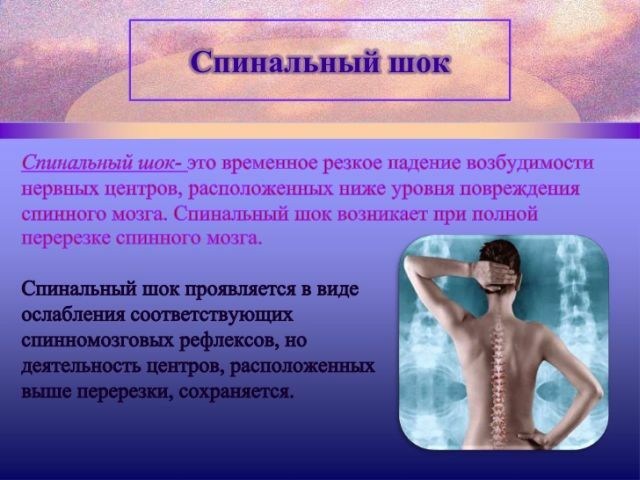 Opticology or Devik's disease was studied and described as early as 1894 by the famous French physician E. Devick. It was decided to name the disease in honor of the scientist.
Opticology or Devik's disease was studied and described as early as 1894 by the famous French physician E. Devick. It was decided to name the disease in honor of the scientist.
Unfortunately, today such an interpretation is not very common, because opticomyelitis is often associated with and called multiple sclerosis, because during the course of the disease shows transverse myelitis and optic neuritis.
Features of the pathology
Optiocoelitis is a dangerous disease, which is an acute inflammatory process, which manifests the destruction of myelitis in the human spinal cord.
The consequence of this destructive effect is the formation of an extensive form of transverse myelitis. Plus, these manifestations are added to the dysfunction of the optic nerves, which in turn are expressed in acute or subacute neuritis.
Due to the fact that many scientists are arguing about the origin of the opticomelitis, it is not classified as a separate disease. Often the manifestation of his symptoms is associated with the course of multiple sclerosis. 
Devik's disease is primarily characterized by instant manifestation of neuritis and myelitis. In such situations, experts noticed an interesting fact: regardless of the nature and severity of the disease, the damage to the spinal cord and optic nerves can be diagnosed both jointly and separately.
But in most medical cases, these two symptoms exist together. Their manifestation separately can take time from several months to a year.
The danger of Devik's illness lies in the fact that her symptoms do not immediately manifest themselves. The first signs of the disease can begin to disturb a person only a couple of months after the onset of the pathology.
For this reason, doctors advise you to be as careful as possible to your state of health and when you manifest any anxious and nonspecific symptoms in an immediate order to seek medical help.
Causes of the occurrence of
Experts have not been able to fully study the causes that provoke damage to the spinal cord and nerve endings.
The fact remains that the main provoking factor is the reaction of the autoimmune system. That is, autoimmune cells of the human body begin to attack and attack the living tissues of the whole organism.
The main substance that attracts these cells is aquaporin-4.It is part of the barrier, which acts as a protective shell of the human brain.
 After the brain barrier is damaged and almost destroyed, autoimmune cells switch to the destruction of more healthy and living tissues. First of all, the myelin covering of all nerve cells of the spinal cord, as well as the optic nerves, suffer.
After the brain barrier is damaged and almost destroyed, autoimmune cells switch to the destruction of more healthy and living tissues. First of all, the myelin covering of all nerve cells of the spinal cord, as well as the optic nerves, suffer.
Due to the fact that the impulse in the nerve has lost its functional abilities, the body can not perform its functions independently, as a result of which the adjusted work of the whole organism is knocked out.
When a lesion of the optic nerves occurs, a person loses sight or it abruptly weakens. In the case where the spinal cord breaks down first, a gradual breakdown of those organs located on the affected nerve is observed.
Developing symptomatology of
The main characteristic feature of Devik's disease is the development of neuritis and myelitis. As mentioned earlier, these two pathologies can develop separately and together.
The difference between the duration of their severity can range from several months to several years. Cases where only one of the main signs is manifested is very rare and practically not found in medical practice.
The first and main sign of opticomelitis are attacks of optic neuritis. In this case, a fairly severe and painful lesion of the optic nerves occurs. At this point the patient may lose sight for a while or be blind for life. The lesion can be localized to both one eye and both eyes simultaneously.
The course of myelitis in this case is very pronounced and its symptoms can not be compared with the course of multiple sclerosis. In this  period, the patient exhibits symmetrical changes in the performance of any motor acts by the limbs and the body, the tactile and temperature sensitivity of the skin is also reduced or lost.
period, the patient exhibits symmetrical changes in the performance of any motor acts by the limbs and the body, the tactile and temperature sensitivity of the skin is also reduced or lost.
Unfortunately, not every patient can fully recover from such violations. Some of the changes can stay forever.
In addition to these symptoms, it should be noted the manifestation of such symptoms:
- presence of paresis;
- development of paralysis of the limbs or the whole body;
- changes in the functioning of the intestinal tract;The
- bladder partially ceases to perform its functional abilities.
Diagnosis of
violation Of course, there is nothing pleasant about the development of Devik's disease, but due to the fact that the lesion does not extend to the brain of a person, it is possible to establish all the disorders and changes in the body through the procedure of magnetic resonance imaging( MRI).
With the help of this study, it is possible to study not only the state of the bone tissue of the spinal cord, but also of adjacent soft tissues, vessels and nerve endings.
In addition to the MRI procedure, it is especially important to conduct a laboratory blood test for the reaction to the presence of special antibodies( aquaparin).
 Often in such an analysis, their presence is established in 90-98% of all cases. With multiple sclerosis, this indicator reaches only 1-2%.
Often in such an analysis, their presence is established in 90-98% of all cases. With multiple sclerosis, this indicator reaches only 1-2%.
These differences are very important to consider when making a diagnosis, as the further treatment and life of the patient depend on the results obtained.
In order to exclude the development of demyelinating encephalitis, it is necessary to conduct tests for the presence of viral and bacterial infections.
Methods of therapy
For the entire time of the existence of Devic's optic kettle, scientists have not been able to invent a drug that could stop the development of destroying autoimmune cells, for this reason, untimely detection of the disease causes the pathology to end in a lethal outcome( life expectancy is 1 or 2year after being diagnosed).
The aim of the treatment itself is to at least slightly improve the patient's well-being and reduce the level of unpleasant symptoms of the disease.
The main methods of therapy are specialized drugs( mitoxantrone and rituximab).It is the substances that make up the  of these medicines that allow for some time to delay the development of pathological processes in the human body.
of these medicines that allow for some time to delay the development of pathological processes in the human body.
In situations of acute disease, a positive effect can be achieved using plasmapheresis.
To support the patient's emotional state, antidepressants, immunosuppressants and glucocorticosteroids are recommended.
The sooner the diagnosis is established and the course of therapy is prescribed, the greater the chance that the disease will be stopped, and the sufferings of the patient will be reduced to a minimum!
Devik's violation is a dangerous disease, often affecting women. In the course of its course, a person loses the ability to move normally, feel and even move about.
The full cure does not lend itself to ailment, however, if the pathology is diagnosed in the early stages of development and the timely supportive treatment is started, the life of the patient can be facilitated and preserved.


